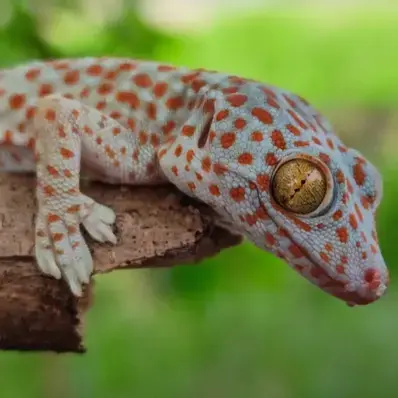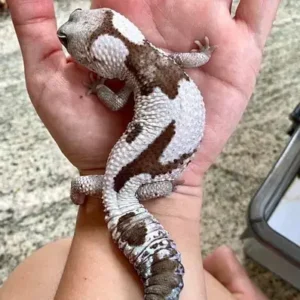History/Origin
The Tokay Gecko has a rich history in the tropical regions of Southeast Asia. It has thrived in diverse environments, from lush rainforests to rural and urban areas. The Tokay Gecko has become a sought-after pet in the reptile enthusiast community. Today, wild Tokay Geckos can be found in the United States and the Caribbean region, where they are considered invasive and pest species.
Personality
Known for their territorial nature, Tokay Geckos are solitary creatures in general. They are known to be vocal, producing loud, distinctive calls that resemble their name, “to-kay.” While not typically considered a handling pet, they can become accustomed to their owners with patient and gentle interaction.
Physical Appearance
The Tokay Gecko is a medium-sized lizard-like creature, with vibrant and striking coloration with distinctive spots. Its large head and unique toe pads contribute to its visually captivating and unmistakable appearance.
- Size
Tokay Geckos can reach lengths of 11 to 20 inches, with males being slightly larger than females.
- Coat Color
Wild-type tokay geckos are pale grayish-blue with orange or red spots. However, captive breeding has expanded the range of available colors and patterns, including shades of blue, green, orange, and red.
Gender Differences
The differences between males and females are minimal in Tokay Geckos. Males may have slightly larger heads, but determining gender through physical traits or behavior is rather difficult. Both males and females look and act similarly in general.
Feed/Nutrition
As insectivores, their diet primarily consists of various insects, which provides the necessary protein and nutrients for their growth.
Here are some key considerations when it comes to feeding and nutrition for Tokay Geckos:
- Insect Selection: A staple in the Tokay Gecko’s diet, crickets are an excellent source of protein. Mealworms are another popular choice. Apart from crickets and mealworms, you can also provide Dubia Roaches. These roaches are nutrient-dense and provide a good balance of protein and fat.
- Gut Loading: Before offering insects to your Tokay Gecko, it’s beneficial to gut load them. This involves feeding the insects a nutritious diet 24 to 48 hours before being consumed by the gecko. This enhances the nutritional content of the insects, ensuring that your gecko receives a well-rounded meal.
- Hydration: While Tokay Geckos obtain a significant portion of their hydration from the insects they consume, it’s essential to provide a shallow water dish within their enclosure.
- Feeding Frequency: Tokay Geckos are generally fed every two to three days. Adjust the quantity based on the gecko’s age, size, and individual metabolism. Monitoring their weight and overall condition is crucial to prevent overfeeding or underfeeding.
Health
Ensuring the health and well-being of Tokay Geckos is paramount for responsible reptile ownership. While these resilient creatures are generally hardy, proper care and attention are essential to prevent common health issues.
Here are some aspects to consider for maintaining the health of your Tokay Gecko:
- Respiratory Health: Due to their short snouts, Tokay Geckos may experience breathing problems, making them prone to Brachycephalic Obstructive Airway Syndrome (BOAS). If you observe signs of respiratory distress or exercise intolerance, seek veterinary care promptly to address any potential breathing concerns.
- Metabolic Bone Disease (MBD) Prevention: Adequate calcium supplementation is crucial to prevent Metabolic Bone Disease, a common ailment in reptiles. Dusting insects with a calcium powder before feeding, providing a UVB light source, and ensuring a well-balanced diet contribute to healthy bone development.
- Monitor Body Condition: Regularly monitor your Tokay Gecko’s body condition by observing its weight and overall appearance. Sudden weight loss, lethargy, or changes in skin texture may indicate underlying health issues. If any abnormalities are noticed, seek professional advice promptly.
- Parasitic Infections: Regularly inspect feces for signs of parasites and maintain good hygiene within the enclosure. Keep the habitat clean, remove waste promptly, and avoid using substrates that might harbor parasites.
- Regular Veterinary Check-ups: Routine veterinary check-ups are crucial to monitor the overall health of your Tokay Gecko. Find a reptile-savvy veterinarian experienced in treating exotic pets. During check-ups, the vet can assess weight, check for signs of respiratory issues, and address any concerns you might have.
Care and Grooming
While these reptiles are generally low-maintenance, attention to their habitat, hygiene, and overall health is essential.
Here’s what caring for your Tokay Gecko includes:
Proper Housing Conditions:
Maintaining the right habitat conditions is vital for the health of Tokay Geckos. Ensure that the enclosure provides the appropriate temperature gradient (with a basking spot and cooler areas), humidity levels, and ample hiding places. Consistent monitoring of these factors will contribute to a stress-free and healthy environment.
- Enclosure Size: Provide a spacious enclosure that allows for climbing and exploration. A 20-gallon tank is suitable for one adult Tokay Gecko.
- Substrate: Choose a substrate that retains moisture, such as coconut coir or cypress mulch. This helps maintain proper humidity levels.
- Hiding Places: Create multiple hiding spots using rocks, branches, or commercially available hides. Tokay Geckos appreciate the shadow while resting.
- Temperature Gradient: Establish a temperature gradient within the enclosure. Maintain a basking spot around 85-90°F (29-32°C) and a cooler area around 75°F (24°C).
- Humidity: Maintain a humidity level of 60-80%. Mist the enclosure regularly, especially during shedding periods, to facilitate proper skin shedding.
Limited Handling:
While Tokay Geckos may tolerate some handling, they are generally not considered pets for frequent interaction. Minimize handling to reduce stress. If handling is necessary, approach your gecko gently and support its body. Avoid sudden movements and allow the gecko to move at its own pace.
Reproduction Considerations:
Having multiple Tokay Geckos has its challenges, primarily due to their territorial nature and behavior during the breeding season.
You should know the following important considerations:
- Separate Males and Females: If housing multiple geckos, consider separating males and females unless intentional breeding is desired.
- Territorial Nature: Males are territorial and may exhibit aggression toward each other. Provide each gecko sufficient space and hiding spots, ensuring less competition for food and mates.
- Breeding Season: Tokay Geckos typically experience a breeding season. During this period, males may become more vocal and territorial as they encounter the opposite sex.
- Egg-Laying Sites: Females require suitable egg-laying sites during the breeding season. Provide a container with moist substrate to serve as a potential nesting area. This helps create an environment conducive to successful egg laying.
Rescue Groups
There are reptile rescue organizations that may occasionally have Tokay Geckos available for adoption. Check these ones out:
Tokay Gecko for Sale
For those interested in owning a Tokay Gecko, reputable breeders and exotic pet stores are good options.
Interesting Tokay Gecko Facts
- Tokay Geckos are named after the loud vocalizations that sound like “to-kay.”
- They have specialized toe pads that allow them to climb vertical surfaces.
- Wild Tokay Geckos outside of Southeast Asia, such as in the Americas, are considered invasive pest species that are harmful for the local species.
Best For
Ideal for reptile enthusiasts and individuals experienced in the care of exotic pets.
Top Names
| Male Tokay Gecko Names | Female Tokay Gecko Names |
| Draco | Luna |
| Ember | Aurora |
| Zephyr | Ivy |
| Nimbus | Saphira |
| Blaze | Ember |









